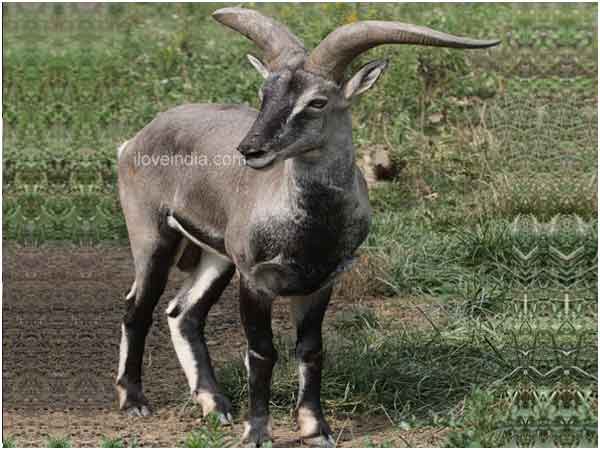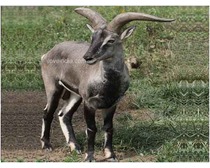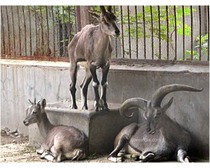Get awestruck by the diverse and incredible facts about Dwarf Blue Sheep, as mentioned here. So, just read on and explore certain interesting facts and amazing information on dwarf blue sheep.
Facts About Dwarf Blue Sheep
Dwarf Blue Sheep is an endangered form of caprid, found in the rocky cliffs and low arid zones of China, particularly in the upper Yangtze gorge of the Sichuan Province and also in a small area called Rong-na in the autonomous Tibet region. The species belongs to the family Bovidae and is considered to be midway between a goat and a sheep. However, recent molecular analyses have indicated that the species is actually more closely related to goats, than sheep. Dwarf blue sheep possess a steely-grey coat, with a unique silvery sheen and usually have a darker hue as compared to the Bharal. According to a survey in the year 2000, it was estimated that only about 200 individuals of the species can be found in the world today. To explore some more interesting facts and amazing information on dwarf blue sheep, read the pointers given below in this article.

Fast Facts
Binomial Name: Pseudois shaeferi
Kingdom: Animalia
Phylum: Chordata
Subphylum: Vertebrata
Class: Mammalia
Order: Artiodactyla
Family: Bovidae
Subfamily: Caprinae
Genus: Pseudois
Species: P. shaeferi
Height: 3 feet (at the shoulder)
Length: 4 to 5.5 feet
Weight: Approximately 25 to 40 kg (50 to 90 pounds)
Life Span: 15-25 years
Diet: Herbivorous, dry gasses in the winter and alpine grasses in the summer
Range: China, upper Yangtze Gorge
Habitat: Low arid grassy slopes
Age of Maturity: 1 to 2 years
Gestation Period: Gestation lasts approximately 150 days
Number of Offspring: One or two infants
Status: Endangered
Interesting & Amazing Information On Dwarf Blue Sheep
-
The dwarf blue sheep fall under the category of the ‘World’s Rarest Animals’.
-
Dwarf blue sheep represents a rare species of mammals, found in certain specific regions in the world. It is midway between a goat and a sheep.
-
The animal is grey to pale brown in color and is more closely related to goats, as compared to sheep.
-
In the year 1963, dwarf blue sheep was categorized as a subspecies of the blue sheep. But, in 1978, it was declared a separate species.
-
These sheep spend most of their summers foraging for food and feeding their young.
-
Due to their limited range, the sheep cannot escape from humans and predators and are regarded as one of the endangered species of the world.
-
Today, the existing number of dwarf blue sheep found in the Batang province is estimated to be between 50 and 200.
-
Female dwarf blue sheep give birth to maximum one or two offspring at a time.
-
The genus name of the sheep ‘Pseudois’ has been derived from the Greek words ‘paeudes’ meaning false and ‘ois’ meaning sheep.
-
These animals are sexually dimorphic, with males being almost double the size of females.
-
The average weight of a female dwarf blue sheep ranges from 17-40 kgs, whereas for a male, its anything from 28-65 kgs.
-
The horns of adult males are large, beautiful and backward sweeping. The females, on the other hand, have small horns.
-
Dwarf blue sheep move around in small groups of 6-10 sheep.
-
Dwarf blue sheep are threatened by habitat degeneration and hunting.
-
These animals are wary by nature and are hence very difficult to observe. It is said that these sheep are at their most active phase early in the morning.
-
The number of these animals declined drastically from the 1960s to the 1980s, in the Tsinghai region of China, wherein enormous amount of the sheep skin was being exported to luxury markets in Europe.
-
In places where there is less vegetation, dwarf blue sheep feed on club moss and other dead plants too.
-
This variety of sheep is known to eat more than 20 varieties of plants found in the world.
-
In some parts of the Sichuan province in China, many locals protect dwarf blue sheep due to a couple of religious beliefs.
-
The gestation period for a female dwarf blue sheep is 160 days and the weaning period starts at 6 months.
-
The offspring of dwarf blue sheep begin grazing on herbage when they are about 3 months of age.
-
The dwarf blue sheep are also known by other names such as Rong-na, Ai Yanyang and Zwergblauschaf.


See also
More from iloveindia.com
- Home Remedies | Ayurveda | Vastu | Yoga | Feng Shui | Tattoos | Fitness | Garden | Nutrition | Parenting | Bikes | Cars | Baby Care | Indian Weddings | Festivals | Party ideas | Horoscope 2015 | Pets | Finance | Figures of Speech | Hotels in India : Delhi | Hyderabad | Chennai | Mumbai | Kolkata | Bangalore | Ahmedabad | Jaipur
- Contact Us Careers Disclaimer Privacy Policy Advertise With Us Lifestyle Sitemap Copyright iloveindia.com. All Rights Reserved.


